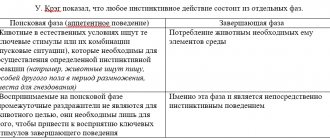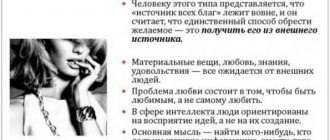In this article we will tell you:
- What is graphology
- Types of handwriting and their decoding
- How to determine a person's character by handwriting
- Full name
- Temperament by handwriting
- Handwriting tells you about a person’s level of responsibility
- The desire to stand out: handwriting and signature
- Handwriting Analysis Examples
- Expert: how to determine a person’s character by handwriting
- Conclusion
The manner of your writing speaks about your temperament, character and mood. In this article we will tell you how to determine a person’s character by handwriting, decipher handwriting, and also show examples.
What is graphology
Graphology is a science that studies the character of an individual based on handwriting. This name was given by the French priest Flandren. If we translate the word “graphology” from Latin, we will see that it consists of two simple words: grapho (I write) and logos (science).
Graphological analysis is a projective method of psychodiagnostics of a personality based on handwriting.
Why can you trust graph analysis?
Have you ever seen the same handwriting in two different people? You may have come across handwritings that are similar in style, but none are absolutely identical.
Why?
Handwriting is formed through fine psychomotor skills of a person. Accordingly, it is formed by what controls psychomotor activity: the central nervous system, as well as conscious and unconscious mechanisms of the psyche. The central nervous system and psyche determine the characteristics of a person’s personality and behavior. Thus, handwriting reflects what we call personality.
Each person has their own unique handwriting. And this is no coincidence. Handwriting clearly reflects a person’s subconscious, and the subconscious is a storehouse of information. It contains everything that is most intimate, something that is sometimes hidden from the person himself.
What can handwriting tell us?
Firstly, handwriting unmistakably shows an introvert or extrovert person. His strengths and weaknesses, level of intelligence (IQ), level of development of emotional intelligence (EQ).
By handwriting you can determine trustworthiness and resistance to stress, life guidelines, principles, attitudes and much more.
Career guidance is a huge area in graphology. With the help of handwriting analysis, you can help both an adult and a child decide on a profession or type of activity.
Diagnosis of a child’s handwriting is possible from the age of 14. Until this age, the child’s personality is in the process of formation, so inaccuracies are possible.
Although, from experience, I can note that even before the age of 14, the main problem areas in children are already noticeable!
Differences in handwriting between men and women
A person’s handwriting always says a lot about his character, while male and female writing styles differ from each other. It is generally accepted that girls' handwriting is always even and legible, while men's handwriting is rude and sloppy.
Boy and girl
Girls often give letters a rounded shape, write in a sweeping manner, and even small letters look legible. Often words are slanted to the right, with strong or medium pressure. Small letters with weak pressure may indicate the presence of chronic diseases, migraines.
Representatives of the stronger sex more often use small letters in words, and when writing, press hard on the pen or pencil. Men's handwriting predominantly consists of sharp angles and clear lines. A man can give even rounded letters an angular shape.
Note! Today, women's and men's rhythms of life are equal to each other. Representatives of the fair sex successfully combine work, raising children and playing sports. If a girl had perfect handwriting as a child, it can change with age along with the pace of her life.
The psychology of handwriting is inseparable from the psychology of personality; by the peculiarities of writing words, you can learn a lot about your colleagues and friends. One person writes each letter, another writes quickly and sweepingly - each of them has their own character and manner of behavior. When analyzing handwriting, every detail matters and can reveal what a person is hiding.
Types of handwriting and their decoding
| Type of handwriting | Decoding |
| Sweeping | Generosity, but at the same time negligence |
| Compressed | Pickiness and pettiness |
| Illegible | Nervousness, haste, hyperactivity |
| Pale | Self-doubt, loneliness |
| Solid | Firmness, determination, confidence in yourself and your actions |
| Trembling | Depression, lack of self-confidence, exposure to fears |
| Large | Openness to new acquaintances, kindness, emotional stability |
| Small | Restraint, determination, secretive lifestyle |
| Stretching | Laziness, relaxation |
| wavy | Deceit, resourcefulness, adventurousness |
| Straight | Restraint, prudence, adequate self-esteem |
How to determine a person's character by handwriting?
Letter size
When analyzing handwriting, you need to take into account the size of the letters. For example, with age and due to overload, the size of letters in handwriting increases. Information obtained about the handwriting of people between 25 and 45 years old is considered the most reliable.
- Middle letters are the most common. If you come across these letters while studying the handwriting of a person, know that they do not contain specific information about their owner.
- Large written symbols indicate that the wearer has leadership qualities. Most often, such a person is quite emotional and easy to communicate with; he has no problems making acquaintances and starting new relationships.
- Lowercase (small) letters speak of determination and restraint. Often such letters indicate a secretive personality.
Pen pressure
How does pen pressure determine character?
- Quite a strong pressure is visible, and this characterizes an energetic, decisive, purposeful, efficient personality. This person always looks at life with optimism.
- If, in addition to strong pressure, there is also a strong bend, then we can say about a principled person who is strict with himself and those around him.
- In the event that there is a soft and rather weak pressure, then one can argue about weakness of will, about the absence of one’s own position or opinion. Such individuals often experience dependence on others. They also include such characteristics as: frivolity, slowness, vulnerability, thoughtfulness, difficulty in making decisions.
3 important steps
which every woman should go through
Anika Snagovskaya
Author and presenter of women's trainings on harmonizing feminine energy. Master of removing limiting beliefs and master of constellations.
I have prepared three lessons for you that will help you better understand yourself, remove the restrictions that prevent you from feeling loved and living happily.
01
Video lesson with meditation: 5 states of femininity
You will learn about 5 female states that exist in every woman, how they manifest themselves and which archetypes are most manifested in you and which are not developed.
02
Video lesson + meditation: How to let go of past relationships
I’ll tell you what you need to do to free your heart from old feelings and break the energy threads connecting you with your past partner.
03
Audio recording: Neuro-af
Thanks to this neuro-affirmation, you can regain self-love and feel sincere gratitude and happiness for every day.
✕
Top 3 useful materials that will help you know yourself better
And start a new, happy life for yourself.
Video lesson with meditation: 5 states of femininity
Video lesson + meditation: How to let go of past relationships
Audio recording: Neuro-af
Take your gifts!
Fields
In addition to the listed characteristics, personality traits can be recognized by handwriting by looking at what fields a person leaves:
- If these are narrow fields, then we can say about such people that they are thrifty. In addition, such a person often exhibits pettiness. The narrower the fields, the more pronounced these qualities are; sometimes a thrifty person turns into a stingy one.
- If these are wide margins, then generosity can be attributed to the author’s personal characteristics. In specific cases, this quality of a person can turn into a negative one, namely wastefulness.
- Too wide brims characterize a person as vain, who constantly desires luxury and brags about it.
Line direction
- “Wavy” lines characterize people who are often prone to mood swings and adventure. In some cases, such lines indicate a person’s tendency to deceive and intelligence.
- Even lines, which are written as if along a ruler, make a statement about such personality characteristics as prudence and restraint. Most often, such people have adequate self-esteem and very correctly assess their capabilities.
- When it is clear that the line is rising, we can talk about an optimistic attitude towards life.
- If the line goes down, then the person has a pessimistic attitude towards life, and most often such individuals have low self-esteem.
Letter shape
- Angular and sharp letters. If you come across this style of writing when studying a person's character through handwriting, then know that it often hints at a sign such as selfishness.
- Round and smooth - pliability and pliability. Such a person treats everyone loyally and usually has difficulty achieving his goals.
Connectedness
What personal information can you find out?
In addition to the shape and inclination of letters, there are other characteristics that indicate personality traits:
- Strong pressure indicates a person’s confidence; he is always concentrated and thinks clearly. Such individuals are rarely interested in other people's problems and experiences;
- Weak pressure on the pencil while writing is a sign of indecisiveness. Responsible work is difficult for a person; he often falls under the influence of others. Frivolous and inattentive people write in almost translucent handwriting and may not complete the last letter of a word;
- By the manner of writing you can determine deviations in mental health. If the written words line up in an even line, the person is balanced. If the letters are lined up unevenly, the words lean in different directions, this indicates an unbalanced psyche. Such people are prone to neuroses, they quickly develop addiction to alcohol, smoking and online games;
- The direction of the line does not speak about a person’s character, but about his mood at the moment. The written line rises upward - this is a sign of optimism and good spirits. The direction of the line down indicates depression and depressive mood;
- Words “floating” in waves are a sign of cunning and deceit. Such people try to mislead everyone and love to gossip;
- The distance between words in a sentence speaks about a person’s attitude towards the people around him. If the intervals are the same, a person treats everyone equally politely, shows respect and tolerance. Different intervals indicate resourcefulness, a tendency to change the manner of communication with different interlocutors;
- Closely arranged letters indicate a person’s need to be in society; loneliness oppresses him;
- If in long words the letters become smaller towards the end, a person may quickly lose interest in work and not finish the job he has started;
- A sweeping signature is a sign of dependence on someone else’s assessment. A modest, no-frills signature speaks of self-confidence. If the signature is partially or completely circled, the owner is shy and does not like to be the center of attention.
Handwriting tells you about a person’s level of responsibility
The topic is serious, pressing, and analysis of a person’s handwriting can be a significant clue for you in the question of how much you can trust him with important matters.
Did you know that there are two types of responsibility? And, of course, by looking at a person’s handwriting, you can understand what kind of responsibility he has.
- Responsibility-reinsurance. Responsibility is not mature, not of one's own free will. Those. a person shows it knowing that they are looking at him. Otherwise, it will be as it happened.
- Adult responsibility. The responsibility of a mature person does not depend on whether people are looking at you or not.
Let's look at two handwritings as an example.
The first handwriting is male, right-handed, 40 years old.
The handwriting looks much younger than the author's age.
The letters are standard, as prescribed. No own inventions. No simplifications, everything is very standard.
Note the emphasis on the middle zone of the letters. Less attention is paid to the upper and lower zones (By the way, let me remind you that we also look at IQ based on them!), everything is focused on oneself.
Round, plump, slightly awkward, banal letters.
The movement is slow.
Is there a feeling of flow, wave, dynamics? No! (+straight tilt, strong pressure).
There is no movement, everything is frozen. Lots of tension.
The strokes are bold, even a little intrusive. There are no thin ligaments at all.
High degree of homogeneity. There is no liveliness, lightness, fluency.
Can you already guess what type of responsibility this handwriting indicates? Yes, “responsibility when someone is watching. Reinsurance.”
And then consider the second handwriting sample:
Girl, 31 years old, right-handed
Tension alternates with relaxation.
Subtle strokes and light connections appear. The text is no longer so bold and intrusive.
The flow of thought is visible (the tilt is already to the right). An undeniable feeling of movement.
This movement takes away the readability a little, because of this the letters are not written out as well. They no longer remind us of copybooks.
The handwriting seems mature and individual.
The level of Personality Development is significantly higher than in the previous version.
Of course, the girl is a truly responsible person.
How to interpret handwriting correctly - life hacks from graphologists
Today, few people write large texts by hand. Almost all business correspondence and documentation is conducted electronically, so graphologists have less and less material to analyze. In cases where it is necessary, specialists work in compliance with certain conditions that increase the reliability of the analysis. Graphologists only consider manuscripts:
- made on white paper in A4 format, not lined;
- written on a flat surface using a blue ballpoint pen. It is advisable that when writing a text, at least 3 sheets of paper should be placed under a piece of paper - this allows you to evaluate the pressure;
- the analyzed text is arbitrary - if a person rewrites ready-made phrases or quotes, he controls himself. For a high-quality graphological examination, free writing in a relaxed state is required, in which unconscious processes will be reflected on paper;
- To conduct a full analysis, 2-3 sentences are not enough. It is advisable that the expert has at least 2-3 fully written A4 pages;
- text samples should be obtained in different time periods. This allows you to track the dynamics of personal development, to separate random factors (mood, well-being) from permanent personality characteristics.
When interpreting a correctly obtained handwriting sample, graphologists take into account the shape of the letters, pressure, fluency of writing, and continuity of the line. Important parameters are the slope, uniformity of the letters, and the shape of the lines.
Irina Sherbul
The desire to stand out: handwriting and signature
There are three common ways to express the desire to stand out in handwriting:
- When handwriting reflects low self-esteem, and the desire to stand out is compensated by the signature: it becomes larger than handwriting, complex, long, with additional elements.
- When the handwriting itself becomes complicated and decorated: loops and elements are added to it.
- If it looks like a copybook, then the person is trying to be effective within the accepted canon of beauty.
- If the handwriting is more careless and/or original, with a left slant, possible angles and/or impulsive movements, then the author of the handwriting is ready for more extravagant solutions.
The first two options reflect a person’s desire to look “better” than he is, to hide his real self. Such a person puts a lot of effort into his appearance, manners, behavior, he has good taste and sensitive self-esteem.
In the second case, a contrast to the world is added: to stand out not so much by beauty as by dissimilarity.
If the changes concern only capital letters, then the author of such handwriting likes to present himself brightly at the first meeting; he knows how to present himself in such a way that you definitely won’t forget such a person. He may have stable self-esteem, or he may have complexes and doubts, but his true nature will still quickly reveal itself.
Handwriting Analysis Examples
Irina Bukhareva is a handwriting expert. She did an analysis of the handwriting of the famous person Sigmund Freud.
There is too much negativity in the handwriting: distortions in forms. His main goal was to bring another person “to the surface.”
Handwriting also reveals many psychological problems and complexes: unhealthy changes in the pressure and tension of the stroke, variability in the middle zone, “brickwork” in the arrangement of words on the lines, fractures in the strokes. All this shows strong emotional stress, an inferiority complex, instability, anxiety, dissatisfaction, anxiety, anger, and depressive tendencies.
There are many contradictions within it. Constant fear, the need to protect yourself from the outside world, because... saw him as a threat, an opposition position. And it was precisely this desire to “bring others to clean water” that served as the true impetus for his theory.











